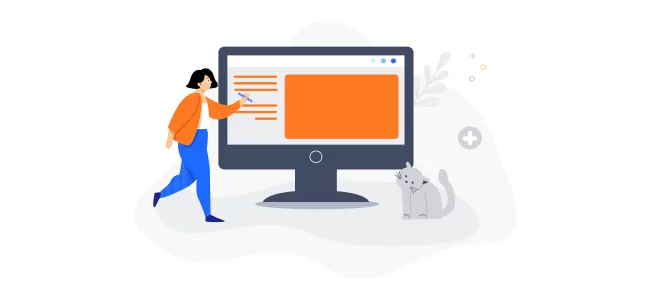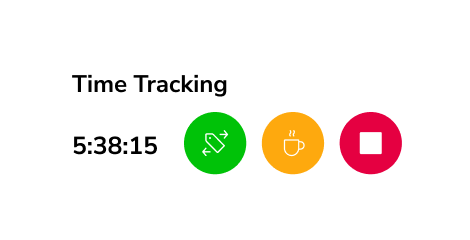Wondering how to keep your private stuff private while your screen’s being monitored?
As the CEO of Jibble, (which has recently introduced an all-free employee screenshot monitoring feature, by the way!) I know a thing or two about screenshot monitoring.
I’m also well aware of how employees can have strong feelings and concerns regarding such practices, seeking ways to avoid them while maintaining productivity and privacy.
In this article, we’ll discuss some responsible ways to get around screenshot monitoring, followed by some cheeky ways to do the same. So, without further ado, read on.
This Article Covers:
- What is Screenshot Monitoring Really?
- Why Do Employers Monitor Employees?
- Responsible Ways to Get Around Screenshot Monitoring
- Cheeky Ways to Avoid Screenshot Monitoring (Not Recommended!)
- What to Look Out for in Jibble’s New Screenshot Monitoring Feature
- Evading Screenshot Monitoring – Is It Worth It?
What is Screenshot Monitoring Really?
Screenshot monitoring software is a tool used in various workplaces, mainly remote work arrangements, to keep track of employee activities.
It involves software that captures screenshots of an employee’s computer screen at random intervals (usually at 10-minute intervals). These screenshots are then stored and made accessible to employers for review and further analysis.
Why Do Employers Monitor Employees?
Employers monitor employees for various reasons, primarily to understand how they spend time at work. However, drawing from my experiences and conversations with industry peers, here’s a more personal take on why we employers really use screenshot monitoring tools.
Their goals may include:
- Spotting where employees might need more training or support.
- Keeping a visual record of project milestones and progress.
- Catching any security issues or misuse of company equipment early.
- Using screenshots as a proof in discussions or disputes about work-related issues.
- Assuring the clients that we’re billing them fairly for the work done.
- Pinpointing and smoothing out any snags in overall workflows.
- Ensuring we’re on the right side of industry regulations and company rules.
- Fostering a workplace culture that values honesty and responsibility.
- Making sure performance reviews are fair and based on real data.
- Preventing false time reporting and encouraging better time management.
- Tailoring rewards and perks to match the real work habits of our team.
Responsible Ways to Get Around Screenshot Monitoring

Photo by Bench Accounting on Unsplash
If you didn’t know already, there are actually some responsible ways you can get around being monitored and control your screen recording. Here are a few:
Tip #1: Plan each work day efficiently
Planning each workday efficiently is all about knowing what you need to do and when you need to do it. Start your day by making a list of your tasks. Put the most important ones at the top.
Then, think about how long each task will take and plan your day around that. This way, when your computer takes a screenshot, it will show you working on something significant. It also helps you stay focused and not get sidetracked by other things.
At the end of the day, take a few minutes to review your accomplishments and prepare for the next day. This helps you track your progress and ensures you don’t miss anything essential. Additionally, doing so during moments when a screenshot is taken demonstrates that you’re focused on work and not engaged in unrelated activities.
Want to know more about managing your day? Read our breakdown of 8 Best Methods of Organizing Time.
Tip #2: Separate work and personal devices
Using different devices for work and personal stuff is a great way to keep things organized. When you’re working, use your work device and save all your personal activities for your personal device.
This means no checking personal emails or social media on your work computer. It helps make sure that if your work computer takes a screenshot, it’s always something work-related. It also keeps your personal information private and separate.
Tip #3: Adhere strictly to company policies and guidelines
Understanding and following your company’s policies is crucial. These policies are there to ensure everyone is working correctly and safely.
Make sure you know what these rules are. They might be about how to use the company’s computers and internet, or how to handle certain kinds of sensitive information. When you diligently follow these rules, you’re always doing the right thing, even if a screenshot is taken.
Tip #4: Initiate open communication with management
Starting a conversation about the monitoring is a good idea. This is your chance to discuss any worries you have and to understand why the monitoring is happening.
This conversation is not just about voicing concerns; it’s also an opportunity to build trust and potentially influence how things are done in the future. By initiating this dialogue, you demonstrate your seriousness and investment in creating a positive work environment.
Tip #5: Adjust privacy settings on your computer
Make sure your computer’s privacy settings are set up correctly to control what information your device can share. Start by going into the privacy settings in the control panel. Here, you can adjust which apps have access to features like your camera or microphone, ensuring only work-related apps have these permissions.
Moreover, pay attention to your internet browser settings, managing cookies and browsing history to minimize personal data collection. This ensures that only work-appropriate information is visible, especially if your computer takes screenshots. It helps maintain a professional environment and keeps your personal information private.
Tip #6: Seek legal advice on workplace monitoring
If you’re not sure about the rules of being monitored at work, and you feel your rights are being violated, it might be a good idea to talk to a legal professional who specializes in employment law. They can tell you about your rights and what’s legally allowed in terms of monitoring.
Once you find a lawyer, set up a consultation to discuss your situation. This way, you’ll gain a deeper understanding of the legalities surrounding workplace monitoring, ensuring you know what’s okay and what’s not.
Learn more about How Far Can Employee Monitoring Go in the US.
Cheeky Ways to Avoid Screenshot Monitoring (Not Recommended!)

Photo by William Fortunato on Pexels
Now that we’ve discussed the responsible ways to navigate the world of screen monitoring, let’s delve into some of the cheekier tactics that employees might think of but really shouldn’t go for.
Method #1: Disabling monitoring software
Some employees might consider disabling or tampering with the monitoring software. While this might seem like an immediate solution, it’s a risky move. Using a firewall, overzealous antivirus that blocks the monitoring app or simply disconnecting the internet could potentially fool some less advanced trackers, but will usually be detected and flagged.
Disabling software can be a breach of company policy and might lead to serious consequences, including disciplinary actions. It shows a lack of trust and cooperation and can significantly damage the employer-employee relationship. It’s a short-term tactic with potentially long-term negative impacts on your career.
Method #2: Using virtual machine environments
Running a virtual machine to simulate a separate operating system might sound clever, but it’s not recommended. This method involves creating a digital workspace that the monitoring software can’t penetrate.
However, it’s technically complicated and often against company policies. It might protect personal activities but can also lead to questions about integrity and professional conduct, damaging your reputation and trustworthiness in the workplace.
Method #3: Maintaining work appearance by keeping idle windows open
Another cheeky method is manipulating the appearance of being busy, like leaving work-related screens open while not actively working. Employees might think this helps them appear productive during screenshot captures.
However, it’s deceptive and doesn’t reflect actual work ethic or productivity. Over time, such tactics can be detected by screen scraping – gathering information shown on the screen and comparing it with previous capture to see if there have been any changes.
Method #4: Automating mouse movements
Automating mouse movements or keystrokes to mimic activity is a tactic some might consider. This involves using software or devices that create the illusion of being active on the computer. Some apps can not only simulate human-like cursor movement, but also scroll pages, switch applications and juggle browser tabs.
While it might fool the monitoring system temporarily, it’s a form of deceit and can have serious repercussions if discovered. Furthermore, software mouse jigglers can be detected by the employer’s software.
Method #5: Utilizing dual monitors
Using dual monitors might seem like a smart workaround, but it can be problematic. The issue here is that monitoring software often captures both screens, so personal activities might still be recorded.
Moreover, using one of the screens for non-work-related activities during work hours can be against company policies. This split attention can also impact your productivity and focus, and if noticed, it might raise questions about your work ethic and dedication.
Method #6: Key clamping
Key clamping involves using a physical tool, like a binder clip, to press on keyboard keys and simulate normal typing activity. However, if the keystrokes are registered, monitoring systems can quickly recognize unusual patterns and flag time entry, notifying supervisors.
This old method becomes almost obsolete when confronted with advanced screenshot monitoring tools.
Method #7: Timing predictable screenshots
If the monitoring software takes screenshots at predictable intervals, such as every 10 minutes, you might time your work activities to coincide with these moments. In the meantime, you could theoretically focus on personal tasks without being caught.
This strategy, aimed at only appearing productive at specific times, is not a genuine reflection of work ethic. It’s a risky game of timing that, if uncovered, could severely impact your credibility and trust with the employer. Consistent hard work and genuine productivity are always the best policies.
Method #8: Manually editing timesheets
Manually editing timesheets to alter work hours or activities is another approach some might consider. This can involve changing recorded times and activities to mask the actual work done, removing screenshots or even adding time manually, especially if monitoring software doesn’t flag manual entries.
This tactic is a clear violation of trust and honesty in the workplace. Falsifying timesheets can have serious implications, including potential legal repercussions, significant disciplinary action or even immediate termination.
What to Look Out for in Jibble’s New Screenshot Monitoring Feature
As I mentioned at the very beginning, Jibble rolled out a fully fledged screenshot monitoring feature – and trust me, it’s something to get excited about.
We’ve thoughtfully designed this with a blend of innovation, privacy, and user respect. It’s not just about keeping track of tasks; it’s about doing it smartly, ethically, and with a human touch. Let me walk you through some standout features that make our approach genuinely unique and, dare I say, revolutionary in the industry:
- Random screenshots every 2, 5 or 10 minutes: First up, we take random screenshots in 2-, 5- or 10-minute intervals. This means fair monitoring without constant pressure. It’s like a periodic check-in rather than constant surveillance.
- Offline data syncing: What if you’re offline? No worries. Our innovative system captures work-related data even then and syncs it once you’re back online. It ensures that work done offline is recognized, too.
- Multiple screens capturing: Working on multiple screens? We’ve got that covered. Our system captures all active screens to give a view of your work, providing an honest, full perspective of your multitasking abilities.
- Selective monitoring control for managers: Managers, you’re going to love this. You can customize monitoring settings for different teams – the right tool for the right team, providing control where it’s needed.
- User consent for screen capturing: Consent is key. We ensure all monitoring is conducted with employee permission. It’s not just ethical; it’s respectful. We believe in monitoring with your approval, not behind your back.
- Blurred screenshots for privacy: Privacy matters. That’s why our screenshots are blurred to protect sensitive information. Plus, employees can view and delete screenshots from their accounts. This way you can maintain privacy while still being accountable.
Don’t forget to see how Jibble fares in comparison with other tools in our lineup of 5 Best FREE Employee Monitoring Software.
Evading Screenshot Monitoring – Is It Worth It?
In the end, trying to evade screenshot tracking might offer short-term relief, but often leads to long-term risks. Responsible strategies like better planning, open communication, and separating personal from work activities are far more effective and sustainable than deceptive tactics that can damage trust or even cost you your job.
With tools like Jibble’s new monitoring feature focusing on consent, fairness, and privacy, the conversation is shifting. Instead of avoiding monitoring, the better question might be: how can we make it work for everyone?
Related Articles:
How to Track Remote Employees (Ethically)
You Need This in Your Next Screenshot Time Tracking Software
How Far Can Desktop Time Trackers Go – Legally?



